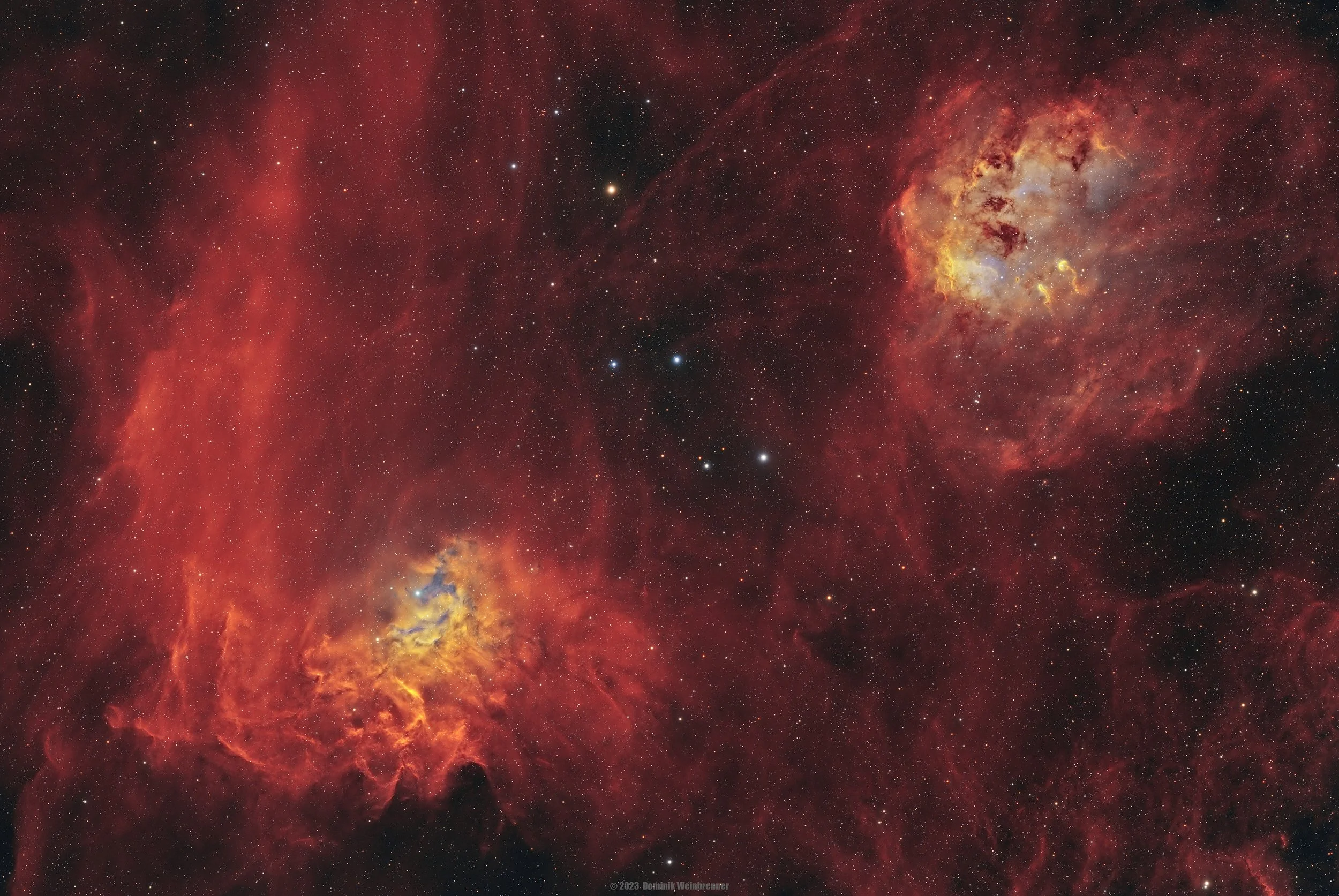
AAPOD2 Image Archives
IC405
Featured Astrophotographer on AAPOD2
IC405-IC410 LRVB
IC 405, the Flaming Star Nebula, and IC 410, home to the Tadpoles, form a stunning pair of emission and reflection nebulae in the constellation Auriga, approximately 1,500 and 12,000 light-years away, respectively. IC 405 glows in rich reds and blues as ultraviolet radiation from the hot, massive star AE Aurigae excites hydrogen gas and scatters starlight off surrounding dust. Meanwhile, IC 410 showcases a pair of dense, tadpole-shaped structures—stellar nurseries shaped by intense stellar winds—set against the glowing hydrogen background.
Captured under the skies of Provence-Alpes-Côte d’Azur, France, these nebulae highlight the dramatic interplay between young stars and the interstellar medium. Their contrasting hues and forms—IC 405’s flowing, fiery streaks versus IC 410’s compact, textured clusters—offer a vivid portrait of stellar evolution. Together, they exemplify the creativity of the cosmos, crafting beauty from chaos in the vast expanse of Auriga.
IC405 Ha-S2 narrowband
In the depths of the night sky lies the striking emission nebula known as IC 405, or the Flaming Star Nebula. Illuminated by the energetic radiation of its central star, AE Aurigae, this cosmic spectacle dazzles with vibrant hues of red and blue. The intricate tendrils of gas and dust stretch across the heavens, sculpted by the fierce stellar winds and intense radiation emanating from AE Aurigae. As hydrogen alpha and sulfur emissions interplay within the nebula, they create a captivating tapestry of light and shadow, offering astronomers a glimpse into the dynamic processes of star formation and stellar evolution.
IC 405 is a testament to the cosmic interplay between stars and the interstellar medium, where massive stars sculpt their surroundings while simultaneously seeding the cosmos with new generations of stellar offspring. As we behold the beauty of the Flaming Star Nebula, we are reminded of the intricate dance of creation and destruction that unfolds throughout the cosmos, shaping the vast tapestry of the universe with its celestial wonders.
A Fire In Auriga
In this captivating bi-color image, the dynamic duo of IC 410 and IC 405 unfolds in the cosmic canvas, revealing the ionized gases captured through hydrogen alpha (Ha) and oxygen (OIII) filters. IC 410, also known as the Tadpoles Nebula, unveils its reddish hues, showcasing regions of intense star formation and ionized hydrogen. Meanwhile, IC 405, the Flaming Star Nebula, bathes in the greenish-blue glow of oxygen emissions.
The Tadpoles Nebula within IC 410 features elongated structures resembling tadpoles, sculpted by the powerful stellar winds and radiation emanating from massive stars within the nebula.
Illuminated by the runaway star AE Aurigae, IC 405 is believed to have been ejected from the Orion Trapezium Cluster millions of years ago, contributing to the unique dynamics of this cosmic region.
flame star IC405 to the ′′ pond ′′ IC410,
From the flame star IC405 to the ′′ pond ′′ IC410, the celestial area in the Giffus is filled with ionized aluminum clouds, the original tone is dominated by red -- until a comet, C / 2020 M3 ATLAS, Dragging the short tail to break into here, bringing a piece of green.
In order to shoot the comet, QHY268C was specially adjusted to high gain mode, Gain 56, Offset 10, with a 100-second short exposure to prevent the comet from dragging. As a result, the comet was captured, but the camera hung up, the infinite card read out, and had to return to the factory for repair. Now, even the equatorial meter is starting to go crazy for unknown reasons.
It seems that the comet is really a broom star......
Location: Hebei Kangbo Galaxy Observatory
Taken on December 9-10, 2020
Telescope: 150 2.8 HNT
Camera: QHY268c
Equator: Eaton iOptron CEM70
Guide: QHYCCD OAG-M
Guide Star Camera: QHY5L-II-M
Number of sheets taken: 206
Single exposure: 100 seconds
Cumulative exposure: 5.7 hours
APT: APT
PixInsight, PhotoShop
Copyright: Steed Yu





